Providing a Photovoltaic Performance Enhancement Relationship from Binary to Ternary Polymer Solar Cells via Machine Learning
Abstract
1. Introduction
2. Materials and Methods
3. Results and Discussion
4. Conclusions
Supplementary Materials
Author Contributions
Funding
Institutional Review Board Statement
Data Availability Statement
Acknowledgments
Conflicts of Interest
References
- Wu, M.; Ma, B.; Li, S.; Han, J.; Zhao, W. Powering the Future: A Critical Review of Research Progress in Enhancing Stability of High-Efficiency Organic Solar Cells. Adv. Funct. Mater. 2023, 33, 2305445. [Google Scholar] [CrossRef]
- Zhang, Y.; Lang, Y.; Li, G. Recent advances of non-fullerene organic solar cells: From materials and morphology to devices and applications. EcoMat 2023, 5, e12281. [Google Scholar] [CrossRef]
- Yi, J.; Zhang, G.; Yu, H.; Yan, H. Advantages, challenges and molecular design of different material types used in organic solar cells. Nat. Rev. Mater. 2024, 9, 46–62. [Google Scholar] [CrossRef]
- Li, S.; Li, Z.; Wan, X.; Chen, Y. Recent progress in flexible organic solar cells. eScience 2023, 3, 100085. [Google Scholar] [CrossRef]
- Li, Y.; Liu, K.-K.; Lin, F.R.; Jen, A.K.-Y. Improving the Stability of Organic Solar Cells: From Materials to Devices. Sol. RRL 2023, 7, 2300531. [Google Scholar] [CrossRef]
- Zhang, X.; Zhang, H.; Li, S.; Xiao, L.; Zhang, S.; Han, B.; Kang, J.; Zhou, H. Development and application of blade-coating technique in organic solar cells. Nano Res. 2023, 16, 11571–11588. [Google Scholar] [CrossRef]
- Günther, M.; Kazerouni, N.; Blätte, D.; Perea, J.D.; Thompson, B.C.; Ameri, T. Models and mechanisms of ternary organic solar cells. Nat. Rev. Mater. 2023, 8, 456–471. [Google Scholar] [CrossRef]
- Suthar, R.; Dahiya, H.; Karak, S.; Sharma, G.D. Ternary Organic Solar Cells: Recent Insight on Structure–Processing–Property–Performance Relationships. Energy Technol. 2023, 11, 2201176. [Google Scholar] [CrossRef]
- Doumon, N.Y.; Yang, L.; Rosei, F. Ternary organic solar cells: A review of the role of the third element. Nano Energy 2022, 94, 106915. [Google Scholar] [CrossRef]
- Chang, L.; Sheng, M.; Duan, L.; Uddin, A. Ternary organic solar cells based on non-fullerene acceptors: A review. Org. Electron. 2021, 90, 106063. [Google Scholar] [CrossRef]
- Tan CA, W.; Wong, B.T. Unraveling the mystery of ternary organic solar cells: A review on the influence of third component on structure–morphology–performance relationships. Sol. RRL 2021, 5, 2100503. [Google Scholar] [CrossRef]
- Zhang, C.; Zhong, X.; Sun, X.; Lv, J.; Ji, Y.; Fu, J.; Zhao, C.; Yao, Y.; Zhang, G.; Deng, W. Designing a Novel Wide Bandgap Small Molecule Guest for Enhanced Stability and Morphology Mediation in Ternary Organic Solar Cells with over 19.3% Efficiency. Adv. Sci. 2024, 2401313. [Google Scholar] [CrossRef] [PubMed]
- Jung, S.; Cho, Y.; Kang, S.-H.; Yoon, S.-J.; Yang, C. Effect of third component on efficiency and stability in ternary organic solar cells: More than a simple superposition. Sol. RRL 2022, 6, 2100819. [Google Scholar] [CrossRef]
- Fan, Z.; Wang, Y.; Xu, S.; Hou, S.; Zhuang, C.; Wang, B. Versatile third components in organic ternary solar cells. Sol. Energy 2022, 231, 732–757. [Google Scholar] [CrossRef]
- Ma, R.; Liu, T.; Luo, Z.; Gao, K.; Chen, K.; Zhang, G.; Gao, W.; Xiao, Y.; Lau, T.-K.; Fan, Q. Adding a third component with reduced miscibility and higher LUMO level enables efficient ternary organic solar cells. ACS Energy Lett. 2020, 5, 2711–2720. [Google Scholar] [CrossRef]
- Xu, X.; Li, Y.; Peng, Q. Ternary blend organic solar cells: Understanding the morphology from recent progress. Adv. Mater. 2022, 34, 2107476. [Google Scholar] [CrossRef] [PubMed]
- Li, S.; Zhan, L.; Li, Y.; He, C.; Zuo, L.; Shi, M.; Chen, H. Achieving and Understanding of Highly Efficient Ternary Organic Photovoltaics: From Morphology and Energy Loss to Working Mechanism. Small Methods 2022, 6, 2200828. [Google Scholar] [CrossRef] [PubMed]
- Mohapatra, A.A.; Tiwari, V.; Patil, S. Energy transfer in ternary blend organic solar cells: Recent insights and future directions. Energy Environ. Sci. 2021, 14, 302–319. [Google Scholar] [CrossRef]
- Zhan, L.; Li, S.; Lau, T.-K.; Cui, Y.; Lu, X.; Shi, M.; Li, C.-Z.; Li, H.; Hou, J.; Chen, H. Over 17% efficiency ternary organic solar cells enabled by two non-fullerene acceptors working in an alloy-like model. Energy Environ. Sci. 2020, 13, 635–645. [Google Scholar] [CrossRef]
- Zhang, W.; Huang, J.; Xu, J.; Han, M.; Su, D.; Wu, N.; Zhang, C.; Xu, A.; Zhan, C. Phthalimide polymer donor guests enable over 17% efficient organic solar cells via parallel-like ternary and quaternary strategies. Adv. Energy Mater. 2020, 10, 2001436. [Google Scholar] [CrossRef]
- Mahmood, A.; Wang, J.-L. Machine learning for high performance organic solar cells: Current scenario and future prospects. Energy Environ. Sci. 2021, 14, 90–105. [Google Scholar] [CrossRef]
- Bansal, N.K.; Mishra, S.; Dixit, H.; Porwal, S.; Singh, P.; Singh, T. Machine learning in perovskite solar cells: Recent developments and future perspectives. Energy Technol. 2023, 11, 2300735. [Google Scholar] [CrossRef]
- Butler, K.T.; Davies, D.W.; Cartwright, H.; Isayev, O.; Walsh, A. Machine learning for molecular and materials science. Nature 2018, 559, 547–555. [Google Scholar] [CrossRef] [PubMed]
- Sahu, H.; Yang, F.; Ye, X.; Ma, J.; Fang, W.; Ma, H. Designing promising molecules for organic solar cells via machine learning assisted virtual screening. J. Mater. Chem. A 2019, 7, 17480–17488. [Google Scholar] [CrossRef]
- Kranthiraja, K.; Saeki, A. Experiment-oriented machine learning of polymer: Non-fullerene organic solar cells. Adv. Funct. Mater. 2021, 31, 2011168. [Google Scholar] [CrossRef]
- Huang, D.; Wang, K.; Li, Z.; Zhou, H.; Zhao, X.; Peng, X.; Wu, J.; Liang, J.; Meng, J.; Zhao, L. A machine learning prediction model for quantitative analyzing the influence of non-radiative voltage loss on non-fullerene organic solar cells. Chem. Eng. J. 2023, 475, 145958. [Google Scholar] [CrossRef]
- Jørgensen, P.B.; Mesta, M.; Shil, S.; García Lastra, J.M.; Jacobsen, K.W.; Thygesen, K.S.; Schmidt, M.N. Machine learning-based screening of complex molecules for polymer solar cells. J. Chem. Phys. 2018, 148, 241735. [Google Scholar] [CrossRef] [PubMed]
- Wang, K.; Guo, C.; Li, Z.; Zhang, R.; Feng, Z.; Fang, G.; Huang, D.; Liang, J.; Zhao, L.; Li, Z. Machine learning assisted identification of the matched energy level of materials for high open circuit voltage in binary organic solar cells. Mol. Syst. Des. Eng. 2023, 8, 799–809. [Google Scholar] [CrossRef]
- Buratti, Y.; Eijkens, C.; Hameiri, Z. Optimization of solar cell production lines using neural networks and genetic algorithms. ACS Appl. Energy Mater. 2020, 3, 10317–10322. [Google Scholar] [CrossRef]
- Malhotra, P.; Khandelwal, K.; Biswas, S.; Chen, F.-C.; Sharma, G.D. Opportunities and challenges for machine learning to select combination of donor and acceptor materials for efficient organic solar cells. J. Mater. Chem. C 2022, 10, 17781–17811. [Google Scholar] [CrossRef]
- Majeed, N.; Saladina, M.; Krompiec, M.; Greedy, S.; Deibel, C.; MacKenzie, R.C. Using deep machine learning to understand the physical performance bottlenecks in novel thin-film solar cells. Adv. Funct. Mater. 2020, 30, 1907259. [Google Scholar] [CrossRef]
- Wang, H.; Feng, J.; Dong, Z.; Jin, L.; Li, M.; Yuan, J.; Li, Y. Efficient screening framework for organic solar cells with deep learning and ensemble learning. npj Comput. Mater. 2023, 9, 200. [Google Scholar] [CrossRef]
- Shi, Y.; Shi, H.; Zhang, Y.; Zang, X.; Zhao, Z.; Zhao, S.; Qiao, B.; Liang, Z.; Xu, Z.; Wang, L. Identifying the Quantitative Relationship Between the Molecular Structure and the Horizontal Transition Dipole Orientation of TADF Emitters. Adv. Opt. Mater. 2024, 12, 2301768. [Google Scholar] [CrossRef]
- Liu, W.; Meng, N.; Huo, X.; Lu, Y.; Zhang, Y.; Huang, X.; Liang, Z.; Zhao, S.; Qiao, B.; Liang, Z. Machine learning enables intelligent screening of interface materials towards minimizing voltage losses for pin type perovskite solar cells. J. Energy Chem. 2023, 83, 128–137. [Google Scholar] [CrossRef]
- Sun, W.; Zheng, Y.; Yang, K.; Zhang, Q.; Shah, A.A.; Wu, Z.; Sun, Y.; Feng, L.; Chen, D.; Xiao, Z. Machine learning–assisted molecular design and efficiency prediction for high-performance organic photovoltaic materials. Sci. Adv. 2019, 5, eaay4275. [Google Scholar] [CrossRef] [PubMed]
- Cao, D.-S.; Xu, Q.-S.; Hu, Q.-N.; Liang, Y.-Z. ChemoPy: Freely available python package for computational biology and chemoinformatics. Bioinformatics 2013, 29, 1092–1094. [Google Scholar] [CrossRef]
- Cao, D.-S.; Hu, Q.-N.; Xu, Q.-S.; Yang, Y.-N.; Zhao, J.-C.; Lu, H.-M.; Zhang, L.-X.; Liang, Y.-Z. In silico classification of human maximum recommended daily dose based on modified random forest and substructure fingerprint. Anal. Chim. Acta 2011, 692, 50–56. [Google Scholar] [CrossRef] [PubMed]
- Muegge, I.; Mukherjee, P. An overview of molecular fingerprint similarity search in virtual screening. Expert Opin. Drug Discov. 2016, 11, 137–148. [Google Scholar] [CrossRef] [PubMed]
- Fang, W.; Zhou, J.; Li, X.; Zhu, K.Q. Unpack local model interpretation for gbdt. In Database Systems for Advanced Applications, Proceedings of the 23rd International Conference, DASFAA 2018, Gold Coast, QLD, Australia, 21–24 May 2018; Proceedings; Part II 23; Springer International Publishing: Berlin/Heidelberg, Germany, 2018; pp. 764–775. [Google Scholar]
- Cheng, P.; Yang, Y. Narrowing the band gap: The key to high-performance organic photovoltaics. Acc. Chem. Res. 2020, 53, 1218–1228. [Google Scholar] [CrossRef] [PubMed]
- Cui, Y.; Zhu, P.; Hu, H.; Xia, X.; Lu, X.; Yu, S.; Chen, Y. Impact of Electrostatic Interaction on Non-radiative Recombination Energy Losses in Organic Solar Cells Based on Asymmetric Acceptors. Angew. Chem. 2023, 135, e202304931. [Google Scholar] [CrossRef]
- Yang, M.; Tan, X.; Yin, B.; Kim, S.; Pang, S.; Chen, Z.; Yang, X.; Yang, C.; Liu, Z.; Duan, C. Near-Infrared Electron Acceptors with Cyano-Substituted 2-(3-Oxo-2, 3-dihydroinden-1-ylidene) malononitrile End-Groups for Organic Solar Cells. ACS Energy Lett. 2023, 8, 2641–2651. [Google Scholar] [CrossRef]
- Yan, L.; Zhang, H.; An, Q.; Jiang, M.; Mahmood, A.; Jee, M.H.; Bai, H.R.; Zhi, H.F.; Zhang, S.; Woo, H.Y. Regioisomer-free difluoro-monochloro terminal-based hexa-halogenated acceptor with optimized crystal packing for efficient binary organic solar cells. Angew. Chem. Int. Ed. 2022, 61, e202209454. [Google Scholar] [CrossRef] [PubMed]
- Chen, Y.; Bai, F.; Peng, Z.; Zhu, L.; Zhang, J.; Zou, X.; Qin, Y.; Kim, H.K.; Yuan, J.; Ma, L.K. Asymmetric alkoxy and alkyl substitution on nonfullerene acceptors enabling high-performance organic solar cells. Adv. Energy Mater. 2021, 11, 2003141. [Google Scholar] [CrossRef]
- Hao, T.; Leng, S.; Yang, Y.; Zhong, W.; Zhang, M.; Zhu, L.; Song, J.; Xu, J.; Zhou, G.; Zou, Y. Capture the high-efficiency non-fullerene ternary organic solar cells formula by machine-learning-assisted energy-level alignment optimization. Patterns 2021, 2, 100333. [Google Scholar] [CrossRef] [PubMed]
- Jiang, W.; Yu, R.; Liu, Z.; Peng, R.; Mi, D.; Hong, L.; Wei, Q.; Hou, J.; Kuang, Y.; Ge, Z. Ternary nonfullerene polymer solar cells with 12.16% efficiency by introducing one acceptor with cascading energy level and complementary absorption. Adv. Mater. 2018, 30, 1703005. [Google Scholar] [CrossRef] [PubMed]
- Liu, J.; Liu, X.; Xin, J.; Zhang, Y.; Wen, L.; Liang, Q.; Miao, Z. Dual Function of the Third Component in Ternary Organic Solar Cells: Broaden the Spectrum and Optimize the Morphology. Small 2024, 2308863. [Google Scholar] [CrossRef] [PubMed]
- Ding, X.; Li, Z. The effect of the third component on high performance ternary organic solar cells: A review. J. Polym. Sci. 2023, 61, 3022–3038. [Google Scholar] [CrossRef]
- Zhang, L.; Ma, W. Morphology optimization in ternary organic solar cells. Chin. J. Polym. Sci. 2017, 35, 184–197. [Google Scholar] [CrossRef]
- Vanden Broeck, G.; Lykov, A.; Schleich, M.; Suciu, D. On the tractability of SHAP explanations. J. Artif. Intell. Res. 2022, 74, 851–886. [Google Scholar] [CrossRef]
- Cui, Y.; Xu, Y.; Yao, H.; Bi, P.; Hong, L.; Zhang, J.; Zu, Y.; Zhang, T.; Qin, J.; Ren, J. Single-junction organic photovoltaic cell with 19% efficiency. Adv. Mater. 2021, 33, 2102420. [Google Scholar] [CrossRef] [PubMed]
- Lu, H.; Ran, G.; Liu, Y.; Pei, Z.; Liu, W.; Liu, Y.; Tang, Z.; Zhang, W.; Bo, Z. Green-Solvent-Processed High-Performance Ternary Organic Solar Cells Comprising a Highly Soluble and Fluorescent Third Component. Adv. Funct. Mater. 2023, 33, 2301866. [Google Scholar] [CrossRef]
- Cui, Y.; Yao, H.; Zhang, J.; Xian, K.; Zhang, T.; Hong, L.; Wang, Y.; Xu, Y.; Ma, K.; An, C. Single-junction organic photovoltaic cells with approaching 18% efficiency. Adv. Mater. 2020, 32, 1908205. [Google Scholar] [CrossRef] [PubMed]
- Luo, D.; Zhang, L.; Zeng, J.; Chi, W.; Zhou, J.; Zhou, E.; Li, L.; Iwahashi, T.; Michinobu, T.; Ouchi, Y. Revealing the Effect of Halogenation Strategy on the Regulation of Crystallization Kinetics and Molecular Packing for High-Performance Organic Solar Cells. Adv. Funct. Mater. 2024, 34, 2311736. [Google Scholar] [CrossRef]
- Yu, H.; Wang, Y.; Zou, X.; Han, H.; Kim, H.K.; Yao, Z.; Wang, Z.; Li, Y.; Ng, H.M.; Zhou, W. Effects of Halogenation of Small-Molecule and Polymeric Acceptors for Efficient Organic Solar Cells. Adv. Funct. Mater. 2023, 33, 2300712. [Google Scholar] [CrossRef]
- Ma, R.; Li, G.; Li, D.; Liu, T.; Luo, Z.; Zhang, G.; Zhang, M.; Wang, Z.; Luo, S.; Yang, T. Understanding the effect of end group halogenation in tuning miscibility and morphology of high-performance small molecular acceptors. Sol. RRL 2020, 4, 2000250. [Google Scholar] [CrossRef]
- Li, C.; Zhou, J.; Song, J.; Xu, J.; Zhang, H.; Zhang, X.; Guo, J.; Zhu, L.; Wei, D.; Han, G. Non-fullerene acceptors with branched side chains and improved molecular packing to exceed 18% efficiency in organic solar cells. Nat. Energy 2021, 6, 605–613. [Google Scholar] [CrossRef]
- Zhang, Y.; Deng, W.; Petoukhoff, C.E.; Xia, X.; Lang, Y.; Xia, H.; Tang, H.; Chandran, H.T.; Mahadevan, S.; Liu, K. Achieving 19.4% organic solar cell via an in situ formation of pin structure with built-in interpenetrating network. Joule 2024, 8, 509–526. [Google Scholar] [CrossRef]
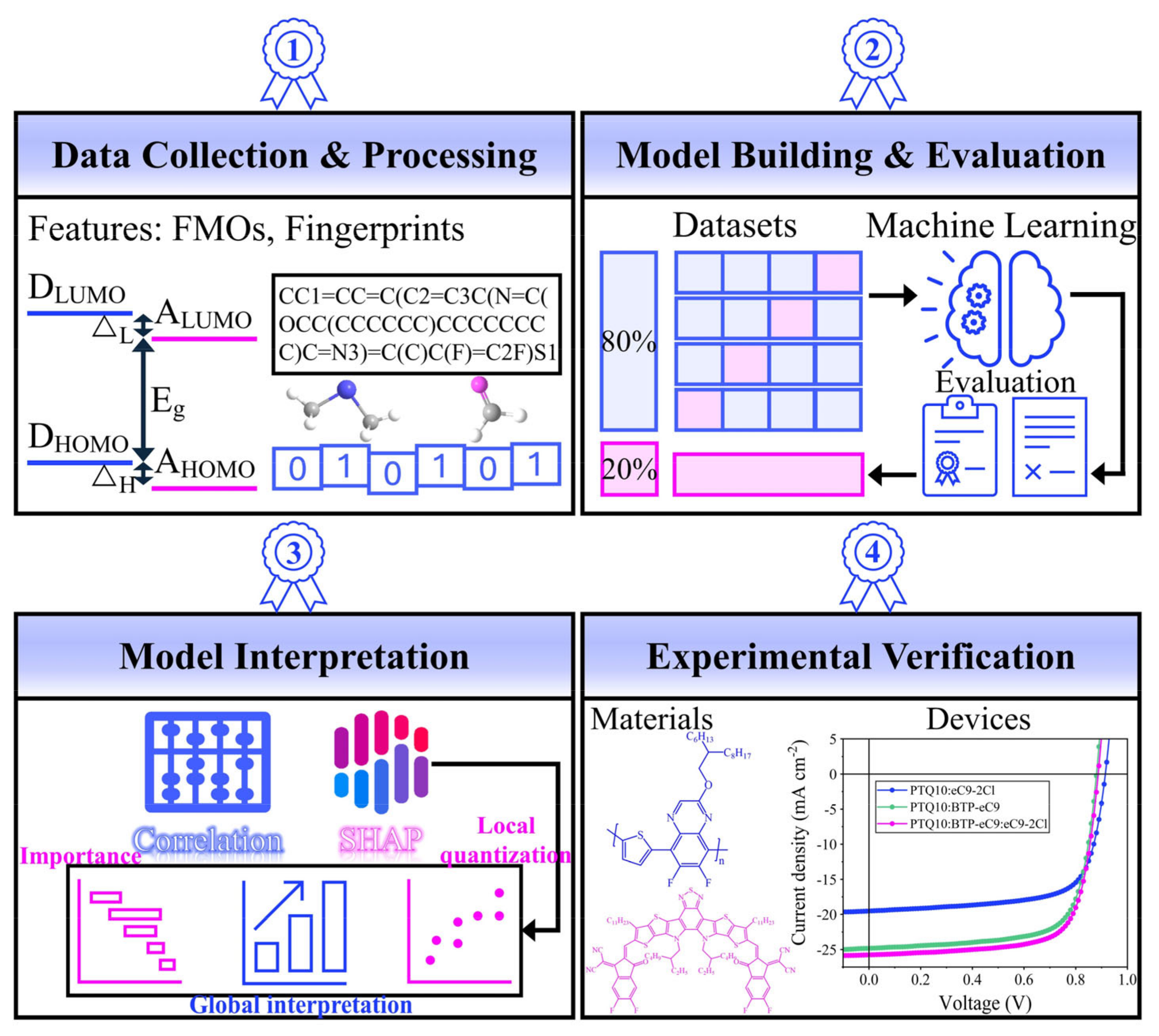

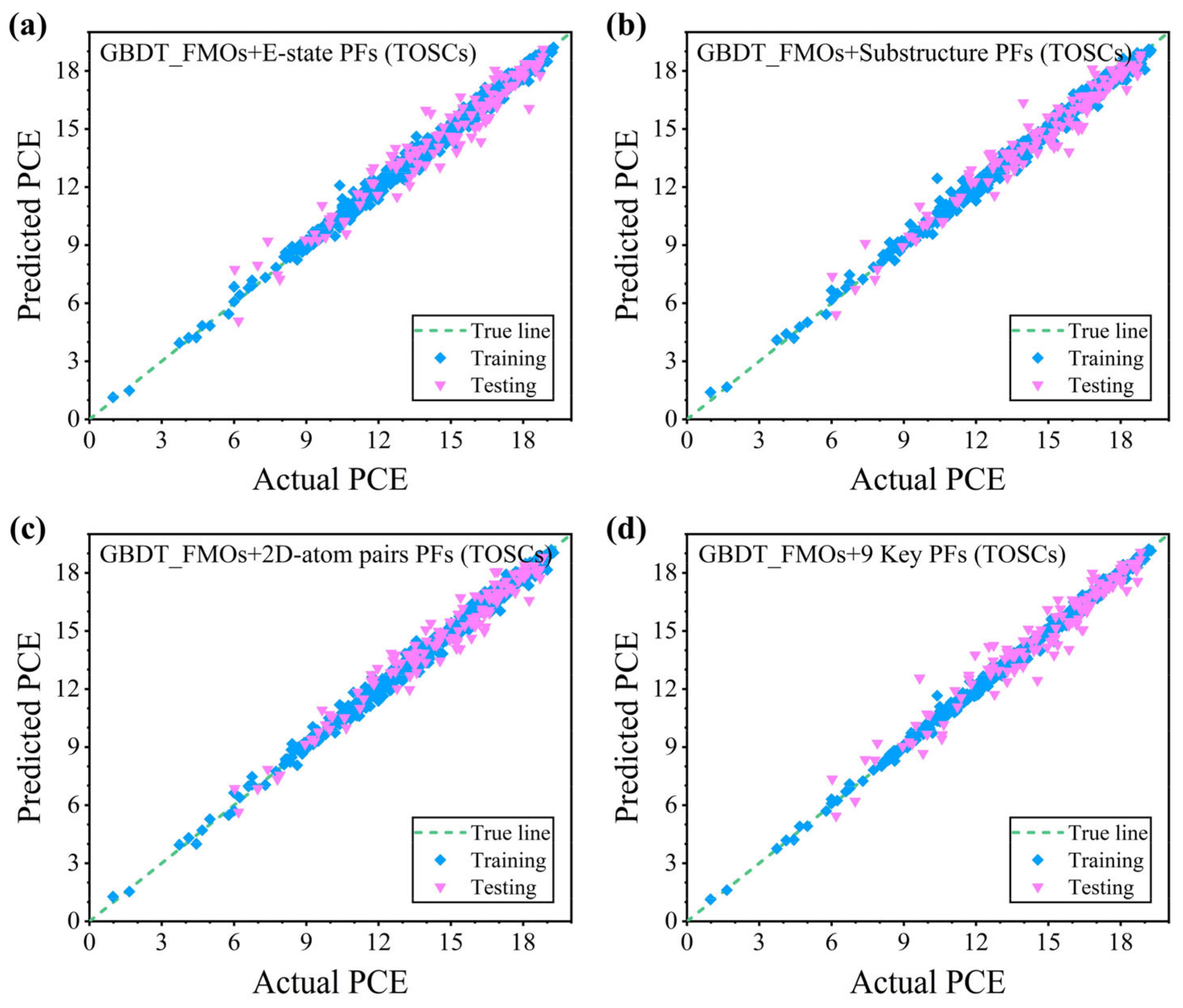
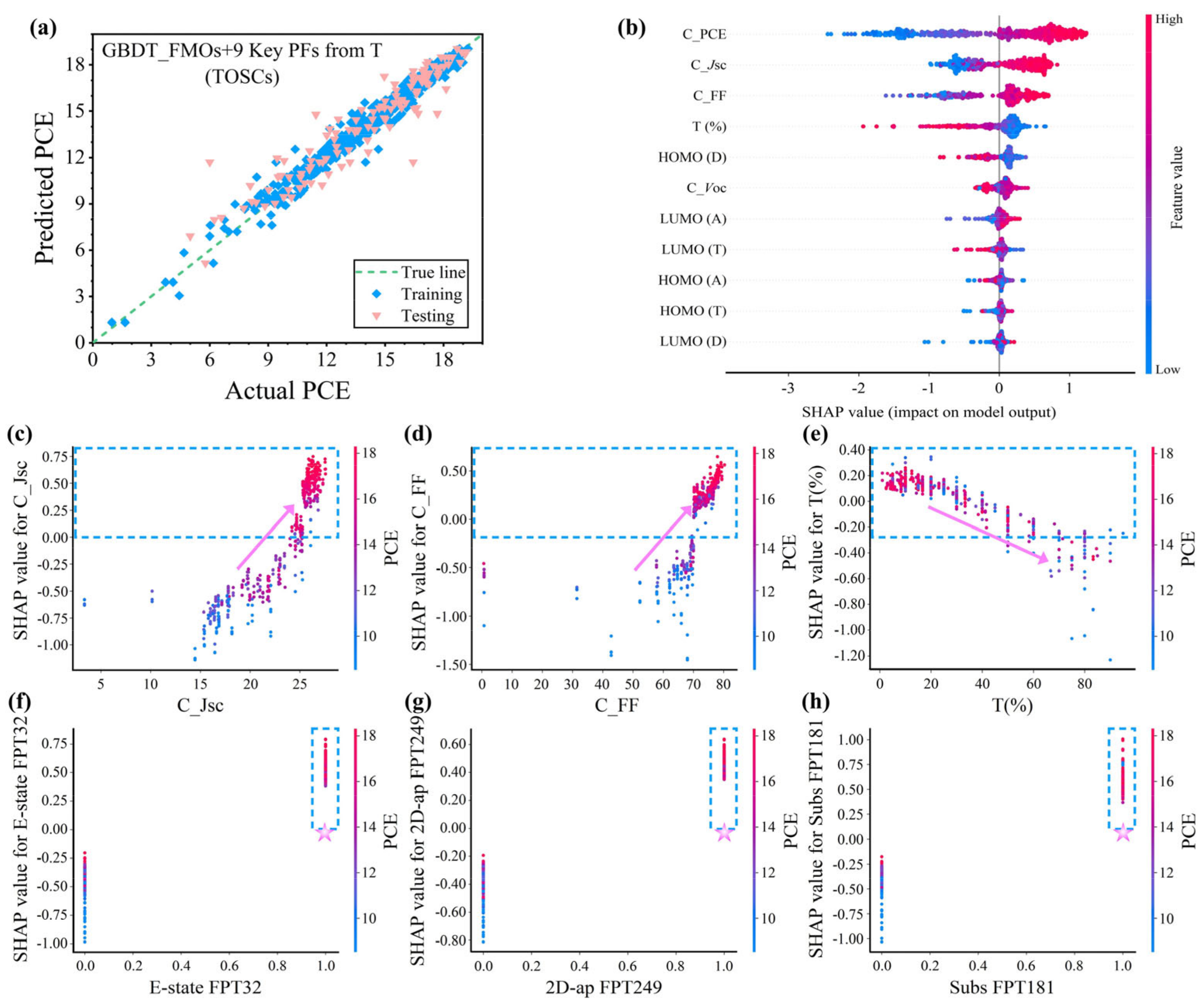
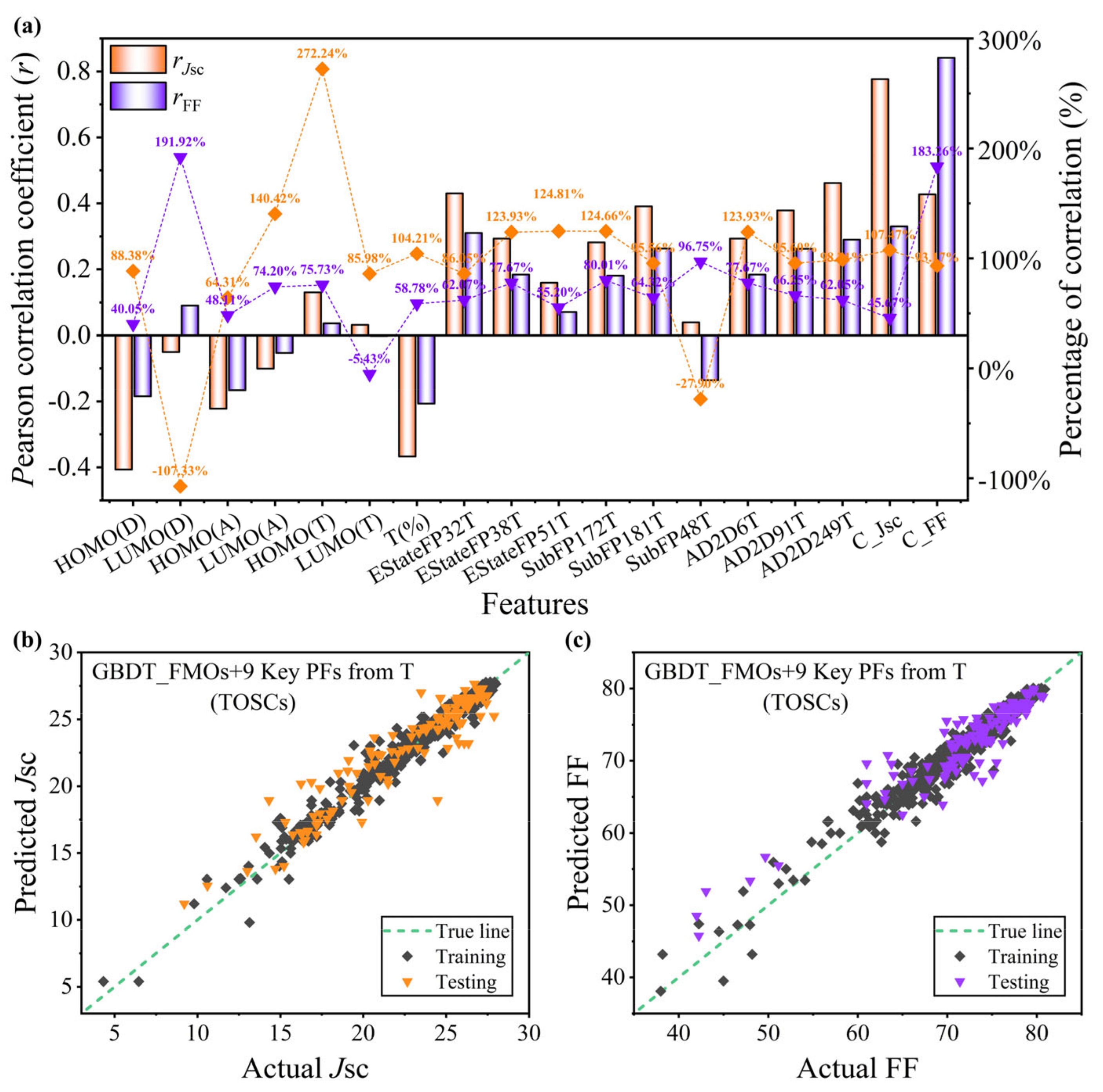
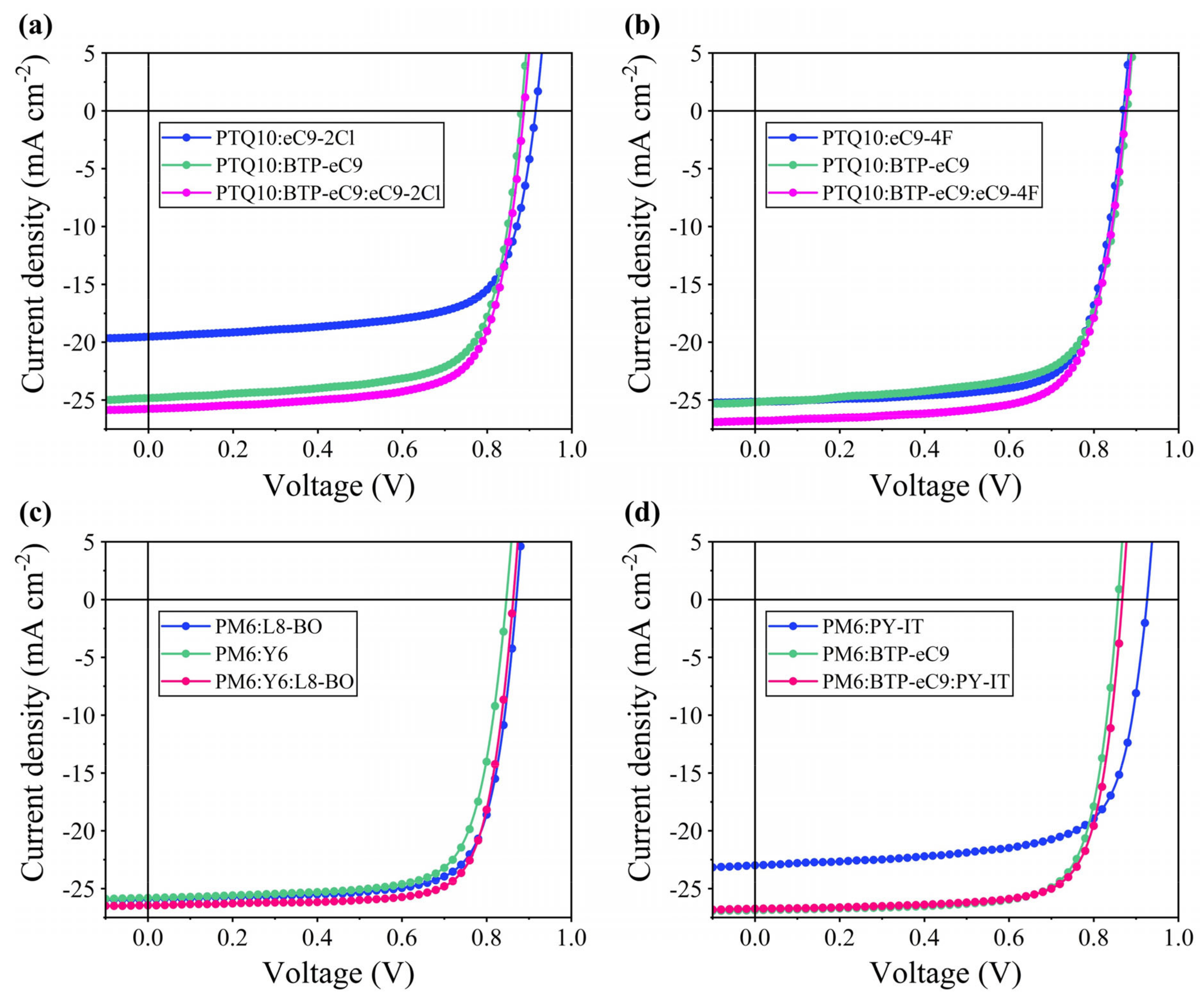
| ML Models | Molecular Fingerprint Types | R2 Train/Test | RMSE Train/Test | MAE Train/Test | MAPE Train/Test |
|---|---|---|---|---|---|
| DT | E-state FPs | 0.876/0.802 | 1.374/1.884 | 1.155/1.619 | 0.394/0.534 |
| Substructure FPs | 0.893/0.828 | 1.426/1.753 | 0.843/1.504 | 0.745/0.426 | |
| 2D-atom-pair FPs | 0.905/0.833 | 1.305/1.728 | 0.918/1.433 | 0.485/0.485 | |
| RF | E-state FPs | 0.939/0.834 | 1.080/1.745 | 0.759/1.381 | 0.754/0.439 |
| Substructure FPs | 0.938/0.856 | 1.075/1.604 | 0.725/1.360 | 0.825/0.451 | |
| 2D-atom-pair FPs | 0.953/0.910 | 0.944/1.330 | 0.668/0.815 | 0.636/0.555 | |
| AdaBoost | E-state FPs | 0.822/0.725 | 1.844/2.490 | 1.484/1.775 | 0.417/0.311 |
| Substructure FPs | 0.849/0.759 | 1.708/2.154 | 1.398/1.481 | 0.464/0.394 | |
| 2D-atom-pair FPs | 0.885/0.795 | 1.396/1.915 | 1.012/1.607 | 0.576/0.439 | |
| XGBoost | E-state FPs | 0.958/0.846 | 0.866/1.661 | 0.637/1.342 | 0.187/0.425 |
| Substructure FPs | 0.947/0.866 | 0.924/1.547 | 0.675/1.355 | 0.176/0.499 | |
| 2D-atom-pair FPs | 0.966/0.901 | 0.821/1.334 | 0.613/0.943 | 0.210/0.479 | |
| GBDT | E-state FPs | 0.980/0.901 | 0.619/1.395 | 0.467/0.874 | 0.129/0.463 |
| Substructure FPs | 0.976/0.893 | 0.685/1.428 | 0.425/0.866 | 0.107/0.351 | |
| 2D-atom-pair FPs | 0.981/0.912 | 0.587/1.311 | 0.412/0.845 | 0.102/0.237 |
| ML Models | Molecular Fingerprint Types | R2 Train/Test | RMSE Train/Test | MAE Train/Test | MAPE Train/Test |
|---|---|---|---|---|---|
| GBDT | E-state FPs | 0.991/0.921 | 0.307/0.854 | 0.239/0.636 | 0.019/0.049 |
| Substructure FPs | 0.992/0.928 | 0.300/0.819 | 0.222/0.587 | 0.018/0.046 | |
| 2D-atom-pair FPs | 0.996/0.934 | 0.218/0.781 | 0.168/0.552 | 0.013/0.043 | |
| 9 Key FPs from BPSCs | 0.968/0.908 | 0.548/0.921 | 0.454/0.695 | 0.032/0.053 | |
| 9 Key FPs from T | 0.935/0.876 | 0.778/1.190 | 0.561/0.796 | 0.044/0.069 |
| Systems | Devices | Voc (V) | Jsc (mA cm−2) | FF (%) | PCE (%) | Predicted PCE (%) | Relative Error (%) |
|---|---|---|---|---|---|---|---|
| PTQ10 | PTQ10:eC9-2Cl | 0.915 | 19.53 | 70.25 | 12.55 | 13.12 | 4.54 |
| PTQ10:BTP-eC9 | 0.880 | 24.83 | 71.75 | 15.68 | 15.74 | 0.38 | |
| PTQ10:BTP-eC9:eC9-2Cl | 0.887 | 25.76 | 72.48 | 16.56 | 16.79 | 1.39 | |
| PTQ10:eC9-4F | 0.870 | 25.15 | 73.58 | 16.10 | 15.88 | 1.37 | |
| PTQ10:BTP-eC9 | 0.878 | 25.20 | 70.81 | 15.66 | 16.12 | 2.94 | |
| PTQ10:BTP-eC9:eC9-4F | 0.876 | 26.80 | 72.06 | 16.92 | 17.14 | 1.30 | |
| PM6 | PM6:L8-BO | 0.871 | 25.91 | 75.32 | 16.99 | 17.31 | 1.88 |
| PM6:Y6 | 0.847 | 25.79 | 74.38 | 16.25 | 15.78 | 2.89 | |
| PM6:Y6:L8-BO | 0.863 | 26.46 | 76.90 | 17.57 | 17.86 | 1.65 | |
| PM6:PY-IT | 0.926 | 22.93 | 71.46 | 15.20 | 15.75 | 3.62 | |
| PM6:BTP-eC9 | 0.858 | 26.87 | 76.11 | 17.55 | 17.23 | 1.82 | |
| PM6:BTP-eC9:PY-IT | 0.868 | 26.74 | 76.60 | 17.78 | 18.03 | 1.41 |
Disclaimer/Publisher’s Note: The statements, opinions and data contained in all publications are solely those of the individual author(s) and contributor(s) and not of MDPI and/or the editor(s). MDPI and/or the editor(s) disclaim responsibility for any injury to people or property resulting from any ideas, methods, instructions or products referred to in the content. |
© 2024 by the authors. Licensee MDPI, Basel, Switzerland. This article is an open access article distributed under the terms and conditions of the Creative Commons Attribution (CC BY) license (https://creativecommons.org/licenses/by/4.0/).
Share and Cite
Cao, J.; Xu, Z. Providing a Photovoltaic Performance Enhancement Relationship from Binary to Ternary Polymer Solar Cells via Machine Learning. Polymers 2024, 16, 1496. https://doi.org/10.3390/polym16111496
Cao J, Xu Z. Providing a Photovoltaic Performance Enhancement Relationship from Binary to Ternary Polymer Solar Cells via Machine Learning. Polymers. 2024; 16(11):1496. https://doi.org/10.3390/polym16111496
Chicago/Turabian StyleCao, Jingyue, and Zheng Xu. 2024. "Providing a Photovoltaic Performance Enhancement Relationship from Binary to Ternary Polymer Solar Cells via Machine Learning" Polymers 16, no. 11: 1496. https://doi.org/10.3390/polym16111496
APA StyleCao, J., & Xu, Z. (2024). Providing a Photovoltaic Performance Enhancement Relationship from Binary to Ternary Polymer Solar Cells via Machine Learning. Polymers, 16(11), 1496. https://doi.org/10.3390/polym16111496





